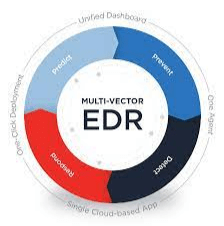Are you worried about your business security? A robust technology like Endpoint Detection & Response (EDR) may be necessary for organizations or MSPs. Many concerns still need to be answered about its operation, the threats it guards against, and the advantages it can give.
This unique technology has helped businesses to protect themselves from severe threats in an effective way. Therefore, before you opt for it, let's dig deeper into what EDR is, How does EDR detect malware, how data is collected, comparison with EPP, and much more in detail!
What Exactly is EDR and How does EDR detect malware?
EDR platforms are tools that keep an eye out for malicious behavior on endpoints (computers on the network, as opposed to the network itself). EDR is an acronym for "endpoint detection and response," coined by Gartner analyst Anton Chuvakin in 2013. EDR solutions are designed to protect personal computers, smartphones, and tablets.
Endpoint detection and response systems (EDR) can see and track malicious software and network intrusions on user endpoints. If you are thinking How does EDR detect malware then keep reading further.

How does EDR detect malware?
Hackers may use any network-connected gadget to gain access to your system and steal sensitive information.
By keeping tabs on your endpoints, EDR solutions help keep your network secure from the numerous new types of threats that traditional antivirus software can't keep up with.
Advanced Persistent Threats (APT) typically utilize malware-free hacking tactics and security flaws to gain access to a network, which is where EDR detects malware and guards against these threats.
Everyone should know by now that no matter how sophisticated a company's defenses are, hackers will find a way to breach them given enough time, money, and motivation. There are several compelling reasons why EDR should be incorporated into your endpoint security policy.
Data Collection By EDR
The EDR software searches for suspicious processes and applications to thwart cyberattacks. To do this, it logs operations, information about executed applications, and file names accessed. This contains information about the following:
- Who has signed into a computer, what applications are executed, and the names of files that are read or written may be monitored.
For instance, if you log in and open a document titled "example.doc" in Microsoft Word, the EDR program will:
- Record the hostname and NetID of the logged-in user.
- A document that Word was executed and collected information about the Word software itself.
- The file name is "Example.doc."
How does EDR detect malware With EDR Scan?
The EDR scan is where EDR examines connections to and from the internet to identify harmful activity. It may track the addresses of visited websites but not the contents of transferred pages. This information is utilized to detect and prevent destructive behaviors on websites.
How Does EDR Detect Malware? : Critical EDR Features
If you think about how EDR Detect Malware then there are features of EDR that help in detection of the malware.
Automatically Detect Hidden Attackers
EDR can apply security reasoning developed from CrowdStrike Intelligence because of its ability to understand individual events as part of a larger sequence. The EDR tool will flag activity as suspicious and provide a warning if it detects a pattern of behavior that fits a previously defined IOA.
Combines With Existing Threat Data
By integrating with CrowdStrike's cyber threat intelligence, suspicious behavior and TTPs may be quickly uncovered. With this, you get a full picture of the attack and its circumstances, along with the identity of the perpetrator and any other pertinent data you may have.
Active Defense via Managed Threat Hunting
Threat hunters are proactively searching for, investigating, and providing advice on suspicious activities in your environment using EDR. After discovering a potential danger, they'll collaborate with your team to triage, investigate, and fix the issue before it can spread and cause major damage.
Displays data in both real-time and over time
Endpoint detection and response (EDR) software functions like a digital video recorder (DVR) on the endpoint, recording pertinent activities to detect attacks that escaped preventative measures.
It monitors hundreds of security-related events, including process creation, driver loading, registry updates, disc access, memory access, and network connections, providing customers with complete visibility into all security-related activity on their endpoints.
Allows for quick and effective correction
Network confinement is a feature of EDR that allows for the isolation of the endpoint. Separating potentially affected computers from all network activity enables enterprises to take immediate and rapid action. it enables enterprises to take immediate and rapid action.
A contained endpoint can continue to communicate with the CrowdStrike cloud, sending and receiving data as usual, but it will remain contained even if its connection to the cloud is lost and will stay that way even after a reboot.
Ending Up!
I hope, now you know everything about EDR, How does EDR detect malware and much more. Get ready to incorporate your businesses and other devices for added protection.
